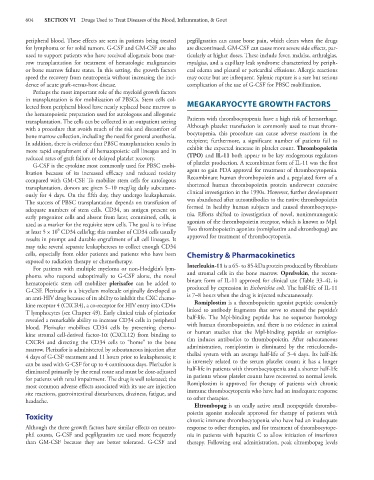Page 618 - Basic _ Clinical Pharmacology ( PDFDrive )
P. 618
604 SECTION VI Drugs Used to Treat Diseases of the Blood, Inflammation, & Gout
peripheral blood. These effects are seen in patients being treated pegfilgrastim can cause bone pain, which clears when the drugs
for lymphoma or for solid tumors. G-CSF and GM-CSF are also are discontinued. GM-CSF can cause more severe side effects, par-
used to support patients who have received allogeneic bone mar- ticularly at higher doses. These include fever, malaise, arthralgias,
row transplantation for treatment of hematologic malignancies myalgias, and a capillary leak syndrome characterized by periph-
or bone marrow failure states. In this setting, the growth factors eral edema and pleural or pericardial effusions. Allergic reactions
speed the recovery from neutropenia without increasing the inci- may occur but are infrequent. Splenic rupture is a rare but serious
dence of acute graft-versus-host disease. complication of the use of G-CSF for PBSC mobilization.
Perhaps the most important role of the myeloid growth factors
in transplantation is for mobilization of PBSCs. Stem cells col-
lected from peripheral blood have nearly replaced bone marrow as MEGAKARYOCYTE GROWTH FACTORS
the hematopoietic preparation used for autologous and allogeneic
transplantation. The cells can be collected in an outpatient setting Patients with thrombocytopenia have a high risk of hemorrhage.
with a procedure that avoids much of the risk and discomfort of Although platelet transfusion is commonly used to treat throm-
bone marrow collection, including the need for general anesthesia. bocytopenia, this procedure can cause adverse reactions in the
In addition, there is evidence that PBSC transplantation results in recipient; furthermore, a significant number of patients fail to
more rapid engraftment of all hematopoietic cell lineages and in exhibit the expected increase in platelet count. Thrombopoietin
reduced rates of graft failure or delayed platelet recovery. (TPO) and IL-11 both appear to be key endogenous regulators
G-CSF is the cytokine most commonly used for PBSC mobi- of platelet production. A recombinant form of IL-11 was the first
lization because of its increased efficacy and reduced toxicity agent to gain FDA approval for treatment of thrombocytopenia.
compared with GM-CSF. To mobilize stem cells for autologous Recombinant human thrombopoietin and a pegylated form of a
transplantation, donors are given 5–10 mcg/kg daily subcutane- shortened human thrombopoietin protein underwent extensive
ously for 4 days. On the fifth day, they undergo leukapheresis. clinical investigation in the 1990s. However, further development
The success of PBSC transplantation depends on transfusion of was abandoned after autoantibodies to the native thrombopoietin
adequate numbers of stem cells. CD34, an antigen present on formed in healthy human subjects and caused thrombocytope-
early progenitor cells and absent from later, committed, cells, is nia. Efforts shifted to investigation of novel, nonimmunogenic
used as a marker for the requisite stem cells. The goal is to infuse agonists of the thrombopoietin receptor, which is known as Mpl.
6
at least 5 × 10 CD34 cells/kg; this number of CD34 cells usually Two thrombopoietin agonists (romiplostim and eltrombopag) are
results in prompt and durable engraftment of all cell lineages. It approved for treatment of thrombocytopenia.
may take several separate leukaphereses to collect enough CD34
cells, especially from older patients and patients who have been Chemistry & Pharmacokinetics
exposed to radiation therapy or chemotherapy.
For patients with multiple myeloma or non-Hodgkin’s lym- Interleukin-11 is a 65- to 85-kDa protein produced by fibroblasts
phoma who respond suboptimally to G-CSF alone, the novel and stromal cells in the bone marrow. Oprelvekin, the recom-
hematopoietic stem cell mobilizer plerixafor can be added to binant form of IL-11 approved for clinical use (Table 33–4), is
G-CSF. Plerixafor is a bicyclam molecule originally developed as produced by expression in Escherichia coli. The half-life of IL-11
an anti-HIV drug because of its ability to inhibit the CXC chemo- is 7–8 hours when the drug is injected subcutaneously.
kine receptor 4 (CXCR4), a co-receptor for HIV entry into CD4+ Romiplostim is a thrombopoietin agonist peptide covalently
T lymphocytes (see Chapter 49). Early clinical trials of plerixafor linked to antibody fragments that serve to extend the peptide’s
revealed a remarkable ability to increase CD34 cells in peripheral half-life. The Mpl-binding peptide has no sequence homology
blood. Plerixafor mobilizes CD34 cells by preventing chemo- with human thrombopoietin, and there is no evidence in animal
kine stromal cell-derived factor-1α (CXCL12) from binding to or human studies that the Mpl-binding peptide or romiplos-
CXCR4 and directing the CD34 cells to “home” to the bone tim induces antibodies to thrombopoietin. After subcutaneous
marrow. Plerixafor is administered by subcutaneous injection after administration, romiplostim is eliminated by the reticuloendo-
4 days of G-CSF treatment and 11 hours prior to leukapheresis; it thelial system with an average half-life of 3–4 days. Its half-life
can be used with G-CSF for up to 4 continuous days. Plerixafor is is inversely related to the serum platelet count; it has a longer
eliminated primarily by the renal route and must be dose-adjusted half-life in patients with thrombocytopenia and a shorter half-life
for patients with renal impairment. The drug is well tolerated; the in patients whose platelet counts have recovered to normal levels.
most common adverse effects associated with its use are injection Romiplostim is approved for therapy of patients with chronic
site reactions, gastrointestinal disturbances, dizziness, fatigue, and immune thrombocytopenia who have had an inadequate response
headache. to other therapies.
Eltrombopag is an orally active small nonpeptide thrombo-
Toxicity poietin agonist molecule approved for therapy of patients with
chronic immune thrombocytopenia who have had an inadequate
Although the three growth factors have similar effects on neutro- response to other therapies, and for treatment of thrombocytope-
phil counts, G-CSF and pegfilgrastim are used more frequently nia in patients with hepatitis C to allow initiation of interferon
than GM-CSF because they are better tolerated. G-CSF and therapy. Following oral administration, peak eltrombopag levels

